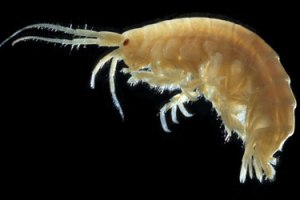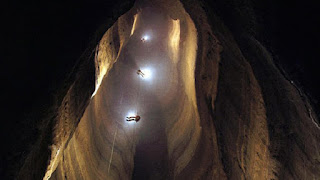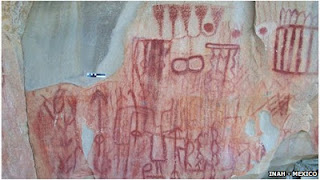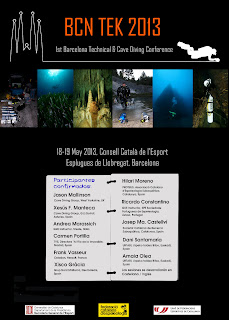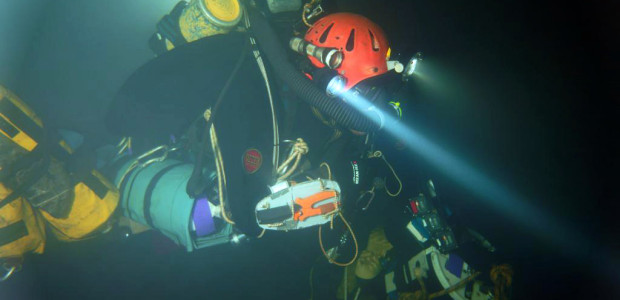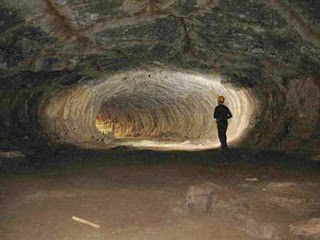Visitors to Hidden River Cave in south-central Kentucky will soon have opportunities for new zipline and rappelling adventures.
The new offerings will begin this coming Saturday.
Adventure seekers will be able to zip over the top of the cave entrance or rappel down the rock face entrance to Hidden River Cave.
Cave tours will still be offered, and all packages include admission to the American Cave Museum.
Also new is a gem mining sluice that allows visitors to pan for their own gemstone.
Hidden River Cave and the American Cave Museum are operated by the American Cave Conservation Association, a not-for-profit organization dedicated to the conservation of caves nationwide.
The two Kentucky attractions are located 2.2 miles off Interstate 65 at Exit 58 at Horse Cave.
Source: WLKY
Monday, June 10, 2013
Hidden River Cave adding zipline, rappelling
Email ThisBlogThis!Share to TwitterShare to FacebookShare to Pinterest
Friday, June 7, 2013
Popular cave in Sequoia National Forest vandalized
 |
| A photo released Wednesday, June 5, 2013, of Packsaddle Cave shows stalactites, some of which were recently damaged in a case of vandalism. |
U.S. Forest Service officials said Wednesday that stalactites were broken off in the cave. The stalactites take at least hundreds of years to form and are irreplaceable, according to officials.
The vandalism occurred inside Packsaddle Cave on the Kern River Ranger District of the Sequoia National Forest. The cave is a popular hiking destination for people visiting the Upper Kern River.
If caught, vandals can be fined up to $5,000.
District Ranger Al Watson is asking anyone with information on the vandal or vandals to call (760) 376-3781 or 379-5646.
Email ThisBlogThis!Share to TwitterShare to FacebookShare to Pinterest
Thursday, June 6, 2013
Slicing Open Stalagmites to Reveal Climate Secrets
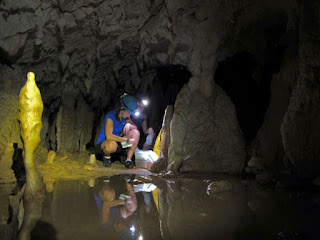 |
| Stacy Carolin collects samples in a Borneo cave last fall. Photo by Syria Lejau |
A few years later, Carolin, a Ph.D. student at Georgia Tech, is breaking ground in the field of paleoclimatology, the study of ancient climates, using an unconventional but increasingly prevalent tool: speleothems, a catch-all term for cave formations that includes stalagmites (remember the mnemonic: those that "mite" reach the ceiling from the floor) and stalactites (those that hold "tite" to the ceiling).
Email ThisBlogThis!Share to TwitterShare to FacebookShare to Pinterest
Saturday, June 1, 2013
Amphipod Species Found In Larissa Cave
A new species of amphipod, unknown until today to scientists, has been found in the cave Melissotripa Elassonas in Larissa, in the region of Thessaly, after research that lasted two years.
The new organism was discovered by German and Romanian speleologists, led by the cavediver Markos Vaxenopoulos, a scientific associate of the Natural History Museum of Volos.
The new species belongs to the genus Nighargus and lives exclusively in a small lake in the cave of Melissotripa. It plays a important role in speleogenesis and its identification was carried out on the basis of its morphological features and the DNA analysis.
According to ethnis.gr, except from this tiny species of amphipod, the researchers also observed in the cave Melissotripa that was first explored in 2007, an array of impressive stalactites and stalagmites, as well as bats.
The cave is easily accessible in its biggest part. However, there are bottlenecks and difficult passages. The temperature in the entrance of the cave reach about 55 degrees Fahrenheit, and about 62 in the interior, where the humidity is 100 percent. There were three lakes in the cave, but now only one of them is left.
The new organism was discovered by German and Romanian speleologists, led by the cavediver Markos Vaxenopoulos, a scientific associate of the Natural History Museum of Volos.
The new species belongs to the genus Nighargus and lives exclusively in a small lake in the cave of Melissotripa. It plays a important role in speleogenesis and its identification was carried out on the basis of its morphological features and the DNA analysis.
According to ethnis.gr, except from this tiny species of amphipod, the researchers also observed in the cave Melissotripa that was first explored in 2007, an array of impressive stalactites and stalagmites, as well as bats.
The cave is easily accessible in its biggest part. However, there are bottlenecks and difficult passages. The temperature in the entrance of the cave reach about 55 degrees Fahrenheit, and about 62 in the interior, where the humidity is 100 percent. There were three lakes in the cave, but now only one of them is left.
Email ThisBlogThis!Share to TwitterShare to FacebookShare to Pinterest
Wednesday, May 29, 2013
Man Rescued From Ellisons Cave
A team of about 80 rescuers took nearly 21 hours to retrieve a North Whitehall Township man from one of the deepest pit caves in the country after he slipped and fell over weekend in Ellisons Cave in Georgia.
Dwight Kempf, 54, had rappelled the 586-foot-deep Fantastic Pit within the Pigeon Mountain Area and fell about 30 feet while walking on a horizontal passageway Sunday afternoon.
Ellisons Cave is in Walker County, about half way between Atlanta and Chattanooga, Tenn., and is the deepest in the East at 1,067 feet. The cave, which includes the Fantastic Pit at 586 feet followed by the Incredible Pit at 440 feet, is 12 miles long and traverses a mountain.
Kempf reportedly fell somewhere between those pits, first falling about 30 feet and landing on rocks and then bouncing and falling another 30-40 feet, according to a rescuer interviewed on ABC News.
Dwight Kempf, 54, had rappelled the 586-foot-deep Fantastic Pit within the Pigeon Mountain Area and fell about 30 feet while walking on a horizontal passageway Sunday afternoon.
Ellisons Cave is in Walker County, about half way between Atlanta and Chattanooga, Tenn., and is the deepest in the East at 1,067 feet. The cave, which includes the Fantastic Pit at 586 feet followed by the Incredible Pit at 440 feet, is 12 miles long and traverses a mountain.
Kempf reportedly fell somewhere between those pits, first falling about 30 feet and landing on rocks and then bouncing and falling another 30-40 feet, according to a rescuer interviewed on ABC News.
Email ThisBlogThis!Share to TwitterShare to FacebookShare to Pinterest
Tuesday, May 28, 2013
Federal Protections For Missouri Cave Fish and Habitat Open to Public Comment
The United States Fish and Wildlife Service is considering an 18-year conservation project aimed at saving the grotto sculpin, a small fish found mostly in cave streams and only within Perry County, Missouri.
Sculpins, as a group, have flattened, scaleless bodies, small eyes, wide mouths, enlarged pectoral fins and large heads that tapers abruptly into a comparatively slender body, which measures approximately 2.5 to 4 inches.
The overall color of the fish, which lays about 200 eggs during the late winter-early spring spawning season, is light tan to bleached tan, with an unpigmented underside.
The wildlife agency says it will cost between $140,000 and $4 million to preserve the species, which was discovered by a college student back in 1991 and is currently not on the federal list of endangered species.
Sculpins, as a group, have flattened, scaleless bodies, small eyes, wide mouths, enlarged pectoral fins and large heads that tapers abruptly into a comparatively slender body, which measures approximately 2.5 to 4 inches.
The overall color of the fish, which lays about 200 eggs during the late winter-early spring spawning season, is light tan to bleached tan, with an unpigmented underside.
The wildlife agency says it will cost between $140,000 and $4 million to preserve the species, which was discovered by a college student back in 1991 and is currently not on the federal list of endangered species.
Email ThisBlogThis!Share to TwitterShare to FacebookShare to Pinterest
Smokies, Mammoth Cave part of MTSU science study
Ten college students from across the country are taking part in a Middle Tennessee State University environmental research project.
The event runs from through July 26 and is funded by the National Science Foundation.
The school says the students will search for ancient inactive seismic faults, investigate water and air quality and explore the ecology of rare cedar glade habitats. The intensified research project involves the disciplines of Earth science, chemistry and biology.
Field trips will take them to Mammoth Cave and the Great Smoky Mountains National Park.
The NSF grant of $368,000 also will enable MTSU to host similar studies in 2014 and 2015.
Source: Kentucky.com
The event runs from through July 26 and is funded by the National Science Foundation.
The school says the students will search for ancient inactive seismic faults, investigate water and air quality and explore the ecology of rare cedar glade habitats. The intensified research project involves the disciplines of Earth science, chemistry and biology.
Field trips will take them to Mammoth Cave and the Great Smoky Mountains National Park.
The NSF grant of $368,000 also will enable MTSU to host similar studies in 2014 and 2015.
Source: Kentucky.com
Email ThisBlogThis!Share to TwitterShare to FacebookShare to Pinterest
Thursday, May 23, 2013
Cave paintings uncovered in Burgos, Mexico
Archaeologists in Mexico have found 4,926 well-preserved cave paintings in the north-eastern region of Burgos.
The images in red, yellow, black and white depict humans, animals and insects, as well as skyscapes and abstract scenes.
The paintings were found in 11 different sites - but the walls of one cave were covered with 1,550 scenes.
The area in which they were found was previously thought not to have been inhabited by ancient cultures.
The paintings suggest that at least three groups of hunter-gatherers dwelled in the San Carlos mountain range.
Experts have not yet been able to date the paintings, but hope to chemically analyse their paint to find out their approximate age.'No objects'
"We have not found any ancient objects linked to the context, and because the paintings are on ravine walls and in the rainy season the sediments are washed away, all we have is gravel," said archaeologist Gustavo Ramirez, from the Mexican National Institute of Anthropology and History (Inah).
In one of the caves, the experts found depictions of the atlatl, a pre-Hispanic hunting weapon that had not yet been seen in other paintings in the Tamaulipas state.
The paintings are being considered an important find because they document the presence of pre-Hispanic peoples in a region where "before it was said that nothing was there", Mr Ramirez said.
The images in red, yellow, black and white depict humans, animals and insects, as well as skyscapes and abstract scenes.
The paintings were found in 11 different sites - but the walls of one cave were covered with 1,550 scenes.
The area in which they were found was previously thought not to have been inhabited by ancient cultures.
The paintings suggest that at least three groups of hunter-gatherers dwelled in the San Carlos mountain range.
Experts have not yet been able to date the paintings, but hope to chemically analyse their paint to find out their approximate age.'No objects'
"We have not found any ancient objects linked to the context, and because the paintings are on ravine walls and in the rainy season the sediments are washed away, all we have is gravel," said archaeologist Gustavo Ramirez, from the Mexican National Institute of Anthropology and History (Inah).
In one of the caves, the experts found depictions of the atlatl, a pre-Hispanic hunting weapon that had not yet been seen in other paintings in the Tamaulipas state.
The paintings are being considered an important find because they document the presence of pre-Hispanic peoples in a region where "before it was said that nothing was there", Mr Ramirez said.
Email ThisBlogThis!Share to TwitterShare to FacebookShare to Pinterest
New cave-dwelling whip scorpion species found
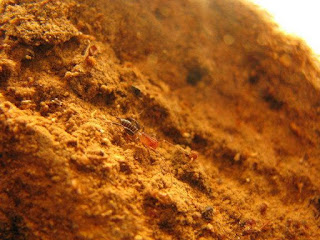 |
| Rowlandius ubajara (above) is one of two new cave-dwelling whip scorpion species discovered in northeastern Brazil. |
Whip scorpions are not true scorpions, but rather part of a group of arachnids that don't have stings and are not poisonous. They possess a whip-like tail, but look more like ants.
Previously, scientists thought whip scorpions came predominantly from the Caribbean. The new species, Rowlandius ubajara and Rowlandius potiguara, are some of the first from South America.
Email ThisBlogThis!Share to TwitterShare to FacebookShare to Pinterest
Sunday, April 21, 2013
Explos Film Festival 2013
8 To 12th May
Ax les Thermes, Ariège Pyrénées
Email ThisBlogThis!Share to TwitterShare to FacebookShare to Pinterest
First Barcelona Technical & Cave Diving Conference: BCN TEK 2013
On 18th & 19th May, the First Barcelona Technical & Cave Diving Conference will take place focusing on cave diving explorations.
Topics presented include :
- recent explorations at the terminal sumps of Sistema Huautla -1545m (Mexico)
- Pozo Azul (over 9km diving distance)
- Lamina'ko Ziloa (Saint Georges system resurgence in the Pyrenees)
- Fuentona de Muriel, Escuain, Cotiella, also explorations in Portugal and Bosnia, ...
Click on the image on the left for the full details about the talks.
More information can be found on the BCN TEK 2013 facebook group, subscription form can be downloaded here.
Email ThisBlogThis!Share to TwitterShare to FacebookShare to Pinterest
Friday, April 19, 2013
Amazing Wingsuit Jump Through Narrow Cave at 155 mph
"Wingsuit / BASE-jump athlete Alexander Polli does a tactical flight through a narrow cave on a rugged mountainside. The flight starts with a jump from a hovering helicopter, Alexander reaches speeds of 250 km/h (155 mph) while following a precise trajectory leading to the cave opening, he then fully commits and flies directly through the narrow opening of the "Batman Cave!"
Shot in full HD, this extraordinary flight exceeds the level of commitment most fliers would ever consider—there can be no attempting, the only option is success!
The narrow cave, no wider than Alexander is tall, is located in Roca Foradada Mountains in Montserrat, Spain—a location that has inspired this professional Italian Norwegian athlete's flying dream his whole life. Alexander hopes his success will inspire others not only to 'climb over their mountains,' but to also fly right through them!"
Video from: www.epictv.com
Email ThisBlogThis!Share to TwitterShare to FacebookShare to Pinterest
Thursday, April 18, 2013
Technique Video: Occam Releasable Anchor
This anchor was developed for use in Canyoneering when you are forced to tie two ropes together to complete a rappel. Specifically, for first descents with unknown rappel lengths.
Email ThisBlogThis!Share to TwitterShare to FacebookShare to Pinterest
Tuesday, April 16, 2013
Cave Depth Record Achieved Using KISS Rebreather
Mexico’s Sistema Huautla is perhaps one of the most complex of the world’s deep caves. With 17 entrances and numerous independent and physically demanding deep routes, dropping nearly a mile into the earth, this dark labyrinth requires extensive rope work and multiple days of effort to reach the lower depths of the system. The last extension to the cave took place in 1994, when Dr William Stone used his self-designed CIS Lunar rebreather to pass what was then considered the terminal sump. Staging their dive from a portable platform suspended over a pool of water, the transiting a flooded tunnel and went on to discovered some 3.3km (2 miles) of new passage, but were ultimately stopped by Sump 9.(...)
Read more: UnderWaterJournal.com
Email ThisBlogThis!Share to TwitterShare to FacebookShare to Pinterest
Discovery of longest lava cave in Southeast Asia
A system of lava caves including one considered as the longest lava cave of Southeast Asia has been discovered in the southern province of Dong Nai, according to researcher Truong Ba Vuong of the Viet Nam's Institute of Tropical Biology.
Researchers from the institute and Germany have surveyed and discovered the system of 11 caves for two months and found the caves formed after an eruption.
The longest cave found is Doi (Bat) Cave which is separated by a geological collapse and rupture that created two additional caves called Bat Cave 1 and Bat Cave 2. The largest section of the cave is about 426m long, 4m high and 10m wide. The explorers consider it as the longest lava cave in Southeast Asia as Gua Lawah Cave in Indonesia, the current longest one, is 400m long.
In some lava caves, researchers discovered many species of animals such as bats, spiders, centipedes, scorpions, cave crickets, flies, ferrets and frogs.
German scientists intend to publish these findings in English, including maps and descriptions of the cave complex, in publications of the Berlin Speleoclub.
The local authorities have called the people to be aware of protecting the complex and stop catching bats in the cave to preserve ecological environment of the site.
Source: VNS
Researchers from the institute and Germany have surveyed and discovered the system of 11 caves for two months and found the caves formed after an eruption.
The longest cave found is Doi (Bat) Cave which is separated by a geological collapse and rupture that created two additional caves called Bat Cave 1 and Bat Cave 2. The largest section of the cave is about 426m long, 4m high and 10m wide. The explorers consider it as the longest lava cave in Southeast Asia as Gua Lawah Cave in Indonesia, the current longest one, is 400m long.
In some lava caves, researchers discovered many species of animals such as bats, spiders, centipedes, scorpions, cave crickets, flies, ferrets and frogs.
German scientists intend to publish these findings in English, including maps and descriptions of the cave complex, in publications of the Berlin Speleoclub.
The local authorities have called the people to be aware of protecting the complex and stop catching bats in the cave to preserve ecological environment of the site.
Source: VNS
Email ThisBlogThis!Share to TwitterShare to FacebookShare to Pinterest
Monday, April 15, 2013
21 st International Karstological School: Classical Karst: Hypogene Speleogenesis (Between theory and reality...)
Since 1993, International Karstological Schools have been organised, covering many aspects of karst research. The basic idea of the School has been to present the state of the art in selected topics and promote discussion between participants via set of lectures, poster sessions and related field trips to the area of Slovene Classical karst.
In the last decade, hypogene speleologenetic processes have attracted attention of speleological community. Many previously epigenic caves have been reinterpreted as hypogene. Some basic publications on the topic have triggered doubts and debates because similar cave patterns and wall rock features considered as hypogene can be formed also under other conditions. Therefore, the aim of the 21'st IKS is to present basic hydrogeological and chemical principles and processes of hypogene speleogenesis as well as geological conditions leading to it. Special attention will be paid to the geometry of cave passages and wall rock features which are often interpreted as hypogene, but could have as well formed otherwise, such as in meteoric flood-water conditions or by dissolution in contact with sediment.
In the last decade, hypogene speleologenetic processes have attracted attention of speleological community. Many previously epigenic caves have been reinterpreted as hypogene. Some basic publications on the topic have triggered doubts and debates because similar cave patterns and wall rock features considered as hypogene can be formed also under other conditions. Therefore, the aim of the 21'st IKS is to present basic hydrogeological and chemical principles and processes of hypogene speleogenesis as well as geological conditions leading to it. Special attention will be paid to the geometry of cave passages and wall rock features which are often interpreted as hypogene, but could have as well formed otherwise, such as in meteoric flood-water conditions or by dissolution in contact with sediment.
Email ThisBlogThis!Share to TwitterShare to FacebookShare to Pinterest
Friday, April 12, 2013
Swiss caver rescued after days in water-filled cavern
A Swiss caver trapped in a water-filled cavern since Wednesday was freed late Friday by a rescue team using divers.
The man, identified as a local resident named Roland Geiser, was pulled from the Cascade cave near Motiers in western Switzerland in good health.
He had become trapped while caving solo on Wednesday when suddenly rising waters -- common this time of year with melting snow -- flooded his exit tunnel. He took refuge in a niche above the water.
Authorities deployed 15 cavers to rescue him, including three divers. They kept him supplied with food and warm clothes while preparing to bring him to the surface.
The man, identified as a local resident named Roland Geiser, was pulled from the Cascade cave near Motiers in western Switzerland in good health.
He had become trapped while caving solo on Wednesday when suddenly rising waters -- common this time of year with melting snow -- flooded his exit tunnel. He took refuge in a niche above the water.
Authorities deployed 15 cavers to rescue him, including three divers. They kept him supplied with food and warm clothes while preparing to bring him to the surface.
Source: Speleo Secours Suisse
Email ThisBlogThis!Share to TwitterShare to FacebookShare to Pinterest
Friday, December 28, 2012
Cave Dwelling Nettle Discovered in China
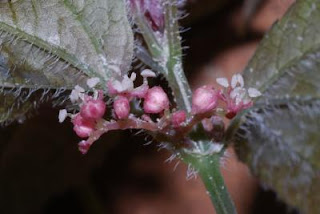 |
| Flowers of a new species from the nettle family known only from caves, Pilea cavernicola, where it grows in very low light conditions. |
South West China, Myanmar and Northern Vietnam contain one of the oldest exposed outcrops of limestone in the world. Within this area are thousands of caves and gorges. It is only recently that botanists have sought to explore the caves for plants. This exploration is yielding many new species new to science, that are known only from these habitats.
The current study was published in the open access journal PhytoKeys.
Kew botanist and nettle expert Alex Monro says, "When my Chinese colleague Wei Yi-Gang from the Guangxi Institute of Botany first mentioned cave-dwelling plants to me, I thought that he was mis-translating a Chinese word into English. When we stepped into our first cave, Yangzi cave, I was spell-bound. It had an eerie moonscape look to it and all I could see were clumps of plants in the nettle family growing in very dark condition."
The plants do not grow in complete darkness but do grow in extremely low light levels, deep within the entrance caverns of the caves (sometimes, in as little as 0.04% full sunlight). The British and Chinese authors have been collecting plants from the Nettle family in this limestone landscape for several years and have just published a paper describing three new species, one from a cave and another two from deep gorges.
The cave-dwelling nettle species in question, was found growing in two caves in the Guangxi province of China. Of the species discovered in gorges, one is known from an unusual and striking rock mineral formation called petaloid travertine. Petaloid travertine is a form of limestone deposited by mineral springs that over time forms large petals of rock, in this case clinging to the vertical walls of a gorge.
These plants are members of a genus of Nettles known as Pilea, that is believed to have over 700 species Worldwide, up to one third of which may remain undescribed.
Journal Reference:
Alex Monro, Y.G. Wei, C.J. Chen. Three new species of Pilea (Urticaceae) from limestone karst in China. PhytoKeys, 2012; 19 (0): 51 DOI:10.3897/phytokeys.19.3968
Kew botanist and nettle expert Alex Monro says, "When my Chinese colleague Wei Yi-Gang from the Guangxi Institute of Botany first mentioned cave-dwelling plants to me, I thought that he was mis-translating a Chinese word into English. When we stepped into our first cave, Yangzi cave, I was spell-bound. It had an eerie moonscape look to it and all I could see were clumps of plants in the nettle family growing in very dark condition."
The plants do not grow in complete darkness but do grow in extremely low light levels, deep within the entrance caverns of the caves (sometimes, in as little as 0.04% full sunlight). The British and Chinese authors have been collecting plants from the Nettle family in this limestone landscape for several years and have just published a paper describing three new species, one from a cave and another two from deep gorges.
The cave-dwelling nettle species in question, was found growing in two caves in the Guangxi province of China. Of the species discovered in gorges, one is known from an unusual and striking rock mineral formation called petaloid travertine. Petaloid travertine is a form of limestone deposited by mineral springs that over time forms large petals of rock, in this case clinging to the vertical walls of a gorge.
These plants are members of a genus of Nettles known as Pilea, that is believed to have over 700 species Worldwide, up to one third of which may remain undescribed.
Journal Reference:
Alex Monro, Y.G. Wei, C.J. Chen. Three new species of Pilea (Urticaceae) from limestone karst in China. PhytoKeys, 2012; 19 (0): 51 DOI:10.3897/phytokeys.19.3968
Email ThisBlogThis!Share to TwitterShare to FacebookShare to Pinterest
Secret caves in Cape York reveal fossilised snake skeletons and link to Dreamtime
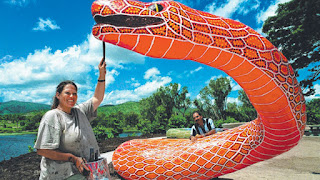 |
| Model of a giant snake known as a madstsoiid |
Fragments of the giant prehistoric snakes, known by the scientific term madtsoiids, that once stalked the Earth have been found by cavers and scientists in the secret "fossil gold mines" of the state's deep north.
Dated back to the Pleistocene epoch, between 2 million and 11,700 years ago, the fossils are believed to be akin to a constricting python, a predator that grew up to 7m long and as thick as a telegraph pole.
Experts question if the giant snakes intersected with the arrival of the earliest humans and if the extinct creature is the latest clue into the mystery of the popular Dreaming story of Australian Aborigines.
The Rainbow Serpent is a story of creation, where a creature of immense proportions moulded the barren earth into mountains, rivers and gorges as it moved across the featureless land.
Email ThisBlogThis!Share to TwitterShare to FacebookShare to Pinterest
Thursday, December 27, 2012
Video: Underground river system of Bramabiau, Farnce
Email ThisBlogThis!Share to TwitterShare to FacebookShare to Pinterest
Subscribe to:
Posts (Atom)
Monday, June 10, 2013
Hidden River Cave adding zipline, rappelling
Visitors to Hidden River Cave in south-central Kentucky will soon have opportunities for new zipline and rappelling adventures.
The new offerings will begin this coming Saturday.
Adventure seekers will be able to zip over the top of the cave entrance or rappel down the rock face entrance to Hidden River Cave.
Cave tours will still be offered, and all packages include admission to the American Cave Museum.
Also new is a gem mining sluice that allows visitors to pan for their own gemstone.
Hidden River Cave and the American Cave Museum are operated by the American Cave Conservation Association, a not-for-profit organization dedicated to the conservation of caves nationwide.
The two Kentucky attractions are located 2.2 miles off Interstate 65 at Exit 58 at Horse Cave.
Source: WLKY
The new offerings will begin this coming Saturday.
Adventure seekers will be able to zip over the top of the cave entrance or rappel down the rock face entrance to Hidden River Cave.
Cave tours will still be offered, and all packages include admission to the American Cave Museum.
Also new is a gem mining sluice that allows visitors to pan for their own gemstone.
Hidden River Cave and the American Cave Museum are operated by the American Cave Conservation Association, a not-for-profit organization dedicated to the conservation of caves nationwide.
The two Kentucky attractions are located 2.2 miles off Interstate 65 at Exit 58 at Horse Cave.
Source: WLKY
Labels:
fun,
Hidden River Cave,
show cave,
USA
Location:
Horse Cave, Kentucky, Verenigde Staten
Friday, June 7, 2013
Popular cave in Sequoia National Forest vandalized
 |
| A photo released Wednesday, June 5, 2013, of Packsaddle Cave shows stalactites, some of which were recently damaged in a case of vandalism. |
U.S. Forest Service officials said Wednesday that stalactites were broken off in the cave. The stalactites take at least hundreds of years to form and are irreplaceable, according to officials.
The vandalism occurred inside Packsaddle Cave on the Kern River Ranger District of the Sequoia National Forest. The cave is a popular hiking destination for people visiting the Upper Kern River.
If caught, vandals can be fined up to $5,000.
District Ranger Al Watson is asking anyone with information on the vandal or vandals to call (760) 376-3781 or 379-5646.
Labels:
cave protection,
law,
Sequoia National Forest,
USA
Location:
Bakersfield, Californië, Verenigde Staten
Thursday, June 6, 2013
Slicing Open Stalagmites to Reveal Climate Secrets
 |
| Stacy Carolin collects samples in a Borneo cave last fall. Photo by Syria Lejau |
A few years later, Carolin, a Ph.D. student at Georgia Tech, is breaking ground in the field of paleoclimatology, the study of ancient climates, using an unconventional but increasingly prevalent tool: speleothems, a catch-all term for cave formations that includes stalagmites (remember the mnemonic: those that "mite" reach the ceiling from the floor) and stalactites (those that hold "tite" to the ceiling).
Labels:
Borneo,
climate,
science,
Stacy Carolin,
stalagmites
Location:
Borneo
Saturday, June 1, 2013
Amphipod Species Found In Larissa Cave
A new species of amphipod, unknown until today to scientists, has been found in the cave Melissotripa Elassonas in Larissa, in the region of Thessaly, after research that lasted two years.
The new organism was discovered by German and Romanian speleologists, led by the cavediver Markos Vaxenopoulos, a scientific associate of the Natural History Museum of Volos.
The new species belongs to the genus Nighargus and lives exclusively in a small lake in the cave of Melissotripa. It plays a important role in speleogenesis and its identification was carried out on the basis of its morphological features and the DNA analysis.
According to ethnis.gr, except from this tiny species of amphipod, the researchers also observed in the cave Melissotripa that was first explored in 2007, an array of impressive stalactites and stalagmites, as well as bats.
The cave is easily accessible in its biggest part. However, there are bottlenecks and difficult passages. The temperature in the entrance of the cave reach about 55 degrees Fahrenheit, and about 62 in the interior, where the humidity is 100 percent. There were three lakes in the cave, but now only one of them is left.
The new organism was discovered by German and Romanian speleologists, led by the cavediver Markos Vaxenopoulos, a scientific associate of the Natural History Museum of Volos.
The new species belongs to the genus Nighargus and lives exclusively in a small lake in the cave of Melissotripa. It plays a important role in speleogenesis and its identification was carried out on the basis of its morphological features and the DNA analysis.
According to ethnis.gr, except from this tiny species of amphipod, the researchers also observed in the cave Melissotripa that was first explored in 2007, an array of impressive stalactites and stalagmites, as well as bats.
The cave is easily accessible in its biggest part. However, there are bottlenecks and difficult passages. The temperature in the entrance of the cave reach about 55 degrees Fahrenheit, and about 62 in the interior, where the humidity is 100 percent. There were three lakes in the cave, but now only one of them is left.
Labels:
amphipod,
biospeleology,
cave diving,
Greece,
Melissotripa Elassonas
Location:
Larissa, Griekenland
Wednesday, May 29, 2013
Man Rescued From Ellisons Cave
A team of about 80 rescuers took nearly 21 hours to retrieve a North Whitehall Township man from one of the deepest pit caves in the country after he slipped and fell over weekend in Ellisons Cave in Georgia.
Dwight Kempf, 54, had rappelled the 586-foot-deep Fantastic Pit within the Pigeon Mountain Area and fell about 30 feet while walking on a horizontal passageway Sunday afternoon.
Ellisons Cave is in Walker County, about half way between Atlanta and Chattanooga, Tenn., and is the deepest in the East at 1,067 feet. The cave, which includes the Fantastic Pit at 586 feet followed by the Incredible Pit at 440 feet, is 12 miles long and traverses a mountain.
Kempf reportedly fell somewhere between those pits, first falling about 30 feet and landing on rocks and then bouncing and falling another 30-40 feet, according to a rescuer interviewed on ABC News.
Dwight Kempf, 54, had rappelled the 586-foot-deep Fantastic Pit within the Pigeon Mountain Area and fell about 30 feet while walking on a horizontal passageway Sunday afternoon.
Ellisons Cave is in Walker County, about half way between Atlanta and Chattanooga, Tenn., and is the deepest in the East at 1,067 feet. The cave, which includes the Fantastic Pit at 586 feet followed by the Incredible Pit at 440 feet, is 12 miles long and traverses a mountain.
Kempf reportedly fell somewhere between those pits, first falling about 30 feet and landing on rocks and then bouncing and falling another 30-40 feet, according to a rescuer interviewed on ABC News.
Labels:
Ellisons Cave,
Search and rescue,
USA
Location:
Georgia, Verenigde Staten
Tuesday, May 28, 2013
Federal Protections For Missouri Cave Fish and Habitat Open to Public Comment
The United States Fish and Wildlife Service is considering an 18-year conservation project aimed at saving the grotto sculpin, a small fish found mostly in cave streams and only within Perry County, Missouri.
Sculpins, as a group, have flattened, scaleless bodies, small eyes, wide mouths, enlarged pectoral fins and large heads that tapers abruptly into a comparatively slender body, which measures approximately 2.5 to 4 inches.
The overall color of the fish, which lays about 200 eggs during the late winter-early spring spawning season, is light tan to bleached tan, with an unpigmented underside.
The wildlife agency says it will cost between $140,000 and $4 million to preserve the species, which was discovered by a college student back in 1991 and is currently not on the federal list of endangered species.
Sculpins, as a group, have flattened, scaleless bodies, small eyes, wide mouths, enlarged pectoral fins and large heads that tapers abruptly into a comparatively slender body, which measures approximately 2.5 to 4 inches.
The overall color of the fish, which lays about 200 eggs during the late winter-early spring spawning season, is light tan to bleached tan, with an unpigmented underside.
The wildlife agency says it will cost between $140,000 and $4 million to preserve the species, which was discovered by a college student back in 1991 and is currently not on the federal list of endangered species.
Labels:
biospeleology,
fish,
protection,
USA
Location:
Perry, Missouri 63462, Verenigde Staten
Smokies, Mammoth Cave part of MTSU science study
Ten college students from across the country are taking part in a Middle Tennessee State University environmental research project.
The event runs from through July 26 and is funded by the National Science Foundation.
The school says the students will search for ancient inactive seismic faults, investigate water and air quality and explore the ecology of rare cedar glade habitats. The intensified research project involves the disciplines of Earth science, chemistry and biology.
Field trips will take them to Mammoth Cave and the Great Smoky Mountains National Park.
The NSF grant of $368,000 also will enable MTSU to host similar studies in 2014 and 2015.
Source: Kentucky.com
The event runs from through July 26 and is funded by the National Science Foundation.
The school says the students will search for ancient inactive seismic faults, investigate water and air quality and explore the ecology of rare cedar glade habitats. The intensified research project involves the disciplines of Earth science, chemistry and biology.
Field trips will take them to Mammoth Cave and the Great Smoky Mountains National Park.
The NSF grant of $368,000 also will enable MTSU to host similar studies in 2014 and 2015.
Source: Kentucky.com
Labels:
Mammoth Cave,
science,
USA
Location:
Murfreesboro, Tennessee, Verenigde Staten
Thursday, May 23, 2013
Cave paintings uncovered in Burgos, Mexico
Archaeologists in Mexico have found 4,926 well-preserved cave paintings in the north-eastern region of Burgos.
The images in red, yellow, black and white depict humans, animals and insects, as well as skyscapes and abstract scenes.
The paintings were found in 11 different sites - but the walls of one cave were covered with 1,550 scenes.
The area in which they were found was previously thought not to have been inhabited by ancient cultures.
The paintings suggest that at least three groups of hunter-gatherers dwelled in the San Carlos mountain range.
Experts have not yet been able to date the paintings, but hope to chemically analyse their paint to find out their approximate age.'No objects'
"We have not found any ancient objects linked to the context, and because the paintings are on ravine walls and in the rainy season the sediments are washed away, all we have is gravel," said archaeologist Gustavo Ramirez, from the Mexican National Institute of Anthropology and History (Inah).
In one of the caves, the experts found depictions of the atlatl, a pre-Hispanic hunting weapon that had not yet been seen in other paintings in the Tamaulipas state.
The paintings are being considered an important find because they document the presence of pre-Hispanic peoples in a region where "before it was said that nothing was there", Mr Ramirez said.
The images in red, yellow, black and white depict humans, animals and insects, as well as skyscapes and abstract scenes.
The paintings were found in 11 different sites - but the walls of one cave were covered with 1,550 scenes.
The area in which they were found was previously thought not to have been inhabited by ancient cultures.
The paintings suggest that at least three groups of hunter-gatherers dwelled in the San Carlos mountain range.
Experts have not yet been able to date the paintings, but hope to chemically analyse their paint to find out their approximate age.'No objects'
"We have not found any ancient objects linked to the context, and because the paintings are on ravine walls and in the rainy season the sediments are washed away, all we have is gravel," said archaeologist Gustavo Ramirez, from the Mexican National Institute of Anthropology and History (Inah).
In one of the caves, the experts found depictions of the atlatl, a pre-Hispanic hunting weapon that had not yet been seen in other paintings in the Tamaulipas state.
The paintings are being considered an important find because they document the presence of pre-Hispanic peoples in a region where "before it was said that nothing was there", Mr Ramirez said.
Labels:
archeology,
cave paintings,
Mexico,
paleontology
Location:
Burgos Municipality, Tamaulipas, Mexico
New cave-dwelling whip scorpion species found
 |
| Rowlandius ubajara (above) is one of two new cave-dwelling whip scorpion species discovered in northeastern Brazil. |
Whip scorpions are not true scorpions, but rather part of a group of arachnids that don't have stings and are not poisonous. They possess a whip-like tail, but look more like ants.
Previously, scientists thought whip scorpions came predominantly from the Caribbean. The new species, Rowlandius ubajara and Rowlandius potiguara, are some of the first from South America.
Labels:
biology,
biospeleology,
Rowlandius ubajara,
science,
scorpion
Location:
Minas Gerais, Brazilië
Sunday, April 21, 2013
Explos Film Festival 2013
8 To 12th May
Ax les Thermes, Ariège Pyrénées
Labels:
Explos Film Festival,
France,
fun,
video
Location:
09110 Ax-les-Thermes, Frankrijk
First Barcelona Technical & Cave Diving Conference: BCN TEK 2013
On 18th & 19th May, the First Barcelona Technical & Cave Diving Conference will take place focusing on cave diving explorations.
Topics presented include :
- recent explorations at the terminal sumps of Sistema Huautla -1545m (Mexico)
- Pozo Azul (over 9km diving distance)
- Lamina'ko Ziloa (Saint Georges system resurgence in the Pyrenees)
- Fuentona de Muriel, Escuain, Cotiella, also explorations in Portugal and Bosnia, ...
Click on the image on the left for the full details about the talks.
More information can be found on the BCN TEK 2013 facebook group, subscription form can be downloaded here.
Labels:
cave diving,
conference,
diving,
Fuentona de Muriel,
Lamina'ko Ziloa,
Pozo Azul,
Sistema Huautla,
Spain
Location:
Barcelona, Spanje
Friday, April 19, 2013
Amazing Wingsuit Jump Through Narrow Cave at 155 mph
"Wingsuit / BASE-jump athlete Alexander Polli does a tactical flight through a narrow cave on a rugged mountainside. The flight starts with a jump from a hovering helicopter, Alexander reaches speeds of 250 km/h (155 mph) while following a precise trajectory leading to the cave opening, he then fully commits and flies directly through the narrow opening of the "Batman Cave!"
Shot in full HD, this extraordinary flight exceeds the level of commitment most fliers would ever consider—there can be no attempting, the only option is success!
The narrow cave, no wider than Alexander is tall, is located in Roca Foradada Mountains in Montserrat, Spain—a location that has inspired this professional Italian Norwegian athlete's flying dream his whole life. Alexander hopes his success will inspire others not only to 'climb over their mountains,' but to also fly right through them!"
Video from: www.epictv.com
Thursday, April 18, 2013
Technique Video: Occam Releasable Anchor
This anchor was developed for use in Canyoneering when you are forced to tie two ropes together to complete a rappel. Specifically, for first descents with unknown rappel lengths.
Tuesday, April 16, 2013
Cave Depth Record Achieved Using KISS Rebreather
Mexico’s Sistema Huautla is perhaps one of the most complex of the world’s deep caves. With 17 entrances and numerous independent and physically demanding deep routes, dropping nearly a mile into the earth, this dark labyrinth requires extensive rope work and multiple days of effort to reach the lower depths of the system. The last extension to the cave took place in 1994, when Dr William Stone used his self-designed CIS Lunar rebreather to pass what was then considered the terminal sump. Staging their dive from a portable platform suspended over a pool of water, the transiting a flooded tunnel and went on to discovered some 3.3km (2 miles) of new passage, but were ultimately stopped by Sump 9.(...)
Read more: UnderWaterJournal.com
Labels:
-1000,
cave diving,
Jason Mallinson,
Mexico,
rebreather,
record,
Sistema Huautla
Location:
Mexico
Discovery of longest lava cave in Southeast Asia
A system of lava caves including one considered as the longest lava cave of Southeast Asia has been discovered in the southern province of Dong Nai, according to researcher Truong Ba Vuong of the Viet Nam's Institute of Tropical Biology.
Researchers from the institute and Germany have surveyed and discovered the system of 11 caves for two months and found the caves formed after an eruption.
The longest cave found is Doi (Bat) Cave which is separated by a geological collapse and rupture that created two additional caves called Bat Cave 1 and Bat Cave 2. The largest section of the cave is about 426m long, 4m high and 10m wide. The explorers consider it as the longest lava cave in Southeast Asia as Gua Lawah Cave in Indonesia, the current longest one, is 400m long.
In some lava caves, researchers discovered many species of animals such as bats, spiders, centipedes, scorpions, cave crickets, flies, ferrets and frogs.
German scientists intend to publish these findings in English, including maps and descriptions of the cave complex, in publications of the Berlin Speleoclub.
The local authorities have called the people to be aware of protecting the complex and stop catching bats in the cave to preserve ecological environment of the site.
Source: VNS
Researchers from the institute and Germany have surveyed and discovered the system of 11 caves for two months and found the caves formed after an eruption.
The longest cave found is Doi (Bat) Cave which is separated by a geological collapse and rupture that created two additional caves called Bat Cave 1 and Bat Cave 2. The largest section of the cave is about 426m long, 4m high and 10m wide. The explorers consider it as the longest lava cave in Southeast Asia as Gua Lawah Cave in Indonesia, the current longest one, is 400m long.
In some lava caves, researchers discovered many species of animals such as bats, spiders, centipedes, scorpions, cave crickets, flies, ferrets and frogs.
German scientists intend to publish these findings in English, including maps and descriptions of the cave complex, in publications of the Berlin Speleoclub.
The local authorities have called the people to be aware of protecting the complex and stop catching bats in the cave to preserve ecological environment of the site.
Source: VNS
Labels:
Bat Cave,
book,
Doi Cave,
Gua Lawah Cave,
Indonesia,
lava tubes,
Vietnam
Location:
58/5 Dốc mơ, Thống Nhất, Đồng Nai, Vietnam
Monday, April 15, 2013
21 st International Karstological School: Classical Karst: Hypogene Speleogenesis (Between theory and reality...)
Since 1993, International Karstological Schools have been organised, covering many aspects of karst research. The basic idea of the School has been to present the state of the art in selected topics and promote discussion between participants via set of lectures, poster sessions and related field trips to the area of Slovene Classical karst.
In the last decade, hypogene speleologenetic processes have attracted attention of speleological community. Many previously epigenic caves have been reinterpreted as hypogene. Some basic publications on the topic have triggered doubts and debates because similar cave patterns and wall rock features considered as hypogene can be formed also under other conditions. Therefore, the aim of the 21'st IKS is to present basic hydrogeological and chemical principles and processes of hypogene speleogenesis as well as geological conditions leading to it. Special attention will be paid to the geometry of cave passages and wall rock features which are often interpreted as hypogene, but could have as well formed otherwise, such as in meteoric flood-water conditions or by dissolution in contact with sediment.
In the last decade, hypogene speleologenetic processes have attracted attention of speleological community. Many previously epigenic caves have been reinterpreted as hypogene. Some basic publications on the topic have triggered doubts and debates because similar cave patterns and wall rock features considered as hypogene can be formed also under other conditions. Therefore, the aim of the 21'st IKS is to present basic hydrogeological and chemical principles and processes of hypogene speleogenesis as well as geological conditions leading to it. Special attention will be paid to the geometry of cave passages and wall rock features which are often interpreted as hypogene, but could have as well formed otherwise, such as in meteoric flood-water conditions or by dissolution in contact with sediment.
Info: http://iks.zrc-sazu.si/en/
Friday, April 12, 2013
Swiss caver rescued after days in water-filled cavern
A Swiss caver trapped in a water-filled cavern since Wednesday was freed late Friday by a rescue team using divers.
The man, identified as a local resident named Roland Geiser, was pulled from the Cascade cave near Motiers in western Switzerland in good health.
He had become trapped while caving solo on Wednesday when suddenly rising waters -- common this time of year with melting snow -- flooded his exit tunnel. He took refuge in a niche above the water.
Authorities deployed 15 cavers to rescue him, including three divers. They kept him supplied with food and warm clothes while preparing to bring him to the surface.
The man, identified as a local resident named Roland Geiser, was pulled from the Cascade cave near Motiers in western Switzerland in good health.
He had become trapped while caving solo on Wednesday when suddenly rising waters -- common this time of year with melting snow -- flooded his exit tunnel. He took refuge in a niche above the water.
Authorities deployed 15 cavers to rescue him, including three divers. They kept him supplied with food and warm clothes while preparing to bring him to the surface.
Source: Speleo Secours Suisse
Labels:
Grotte de la Cascade,
Search and rescue,
Switzerland
Location:
2112 Môtiers, Zwitserland
Friday, December 28, 2012
Cave Dwelling Nettle Discovered in China
 |
| Flowers of a new species from the nettle family known only from caves, Pilea cavernicola, where it grows in very low light conditions. |
South West China, Myanmar and Northern Vietnam contain one of the oldest exposed outcrops of limestone in the world. Within this area are thousands of caves and gorges. It is only recently that botanists have sought to explore the caves for plants. This exploration is yielding many new species new to science, that are known only from these habitats.
The current study was published in the open access journal PhytoKeys.
Kew botanist and nettle expert Alex Monro says, "When my Chinese colleague Wei Yi-Gang from the Guangxi Institute of Botany first mentioned cave-dwelling plants to me, I thought that he was mis-translating a Chinese word into English. When we stepped into our first cave, Yangzi cave, I was spell-bound. It had an eerie moonscape look to it and all I could see were clumps of plants in the nettle family growing in very dark condition."
The plants do not grow in complete darkness but do grow in extremely low light levels, deep within the entrance caverns of the caves (sometimes, in as little as 0.04% full sunlight). The British and Chinese authors have been collecting plants from the Nettle family in this limestone landscape for several years and have just published a paper describing three new species, one from a cave and another two from deep gorges.
The cave-dwelling nettle species in question, was found growing in two caves in the Guangxi province of China. Of the species discovered in gorges, one is known from an unusual and striking rock mineral formation called petaloid travertine. Petaloid travertine is a form of limestone deposited by mineral springs that over time forms large petals of rock, in this case clinging to the vertical walls of a gorge.
These plants are members of a genus of Nettles known as Pilea, that is believed to have over 700 species Worldwide, up to one third of which may remain undescribed.
Journal Reference:
Alex Monro, Y.G. Wei, C.J. Chen. Three new species of Pilea (Urticaceae) from limestone karst in China. PhytoKeys, 2012; 19 (0): 51 DOI:10.3897/phytokeys.19.3968
Kew botanist and nettle expert Alex Monro says, "When my Chinese colleague Wei Yi-Gang from the Guangxi Institute of Botany first mentioned cave-dwelling plants to me, I thought that he was mis-translating a Chinese word into English. When we stepped into our first cave, Yangzi cave, I was spell-bound. It had an eerie moonscape look to it and all I could see were clumps of plants in the nettle family growing in very dark condition."
The plants do not grow in complete darkness but do grow in extremely low light levels, deep within the entrance caverns of the caves (sometimes, in as little as 0.04% full sunlight). The British and Chinese authors have been collecting plants from the Nettle family in this limestone landscape for several years and have just published a paper describing three new species, one from a cave and another two from deep gorges.
The cave-dwelling nettle species in question, was found growing in two caves in the Guangxi province of China. Of the species discovered in gorges, one is known from an unusual and striking rock mineral formation called petaloid travertine. Petaloid travertine is a form of limestone deposited by mineral springs that over time forms large petals of rock, in this case clinging to the vertical walls of a gorge.
These plants are members of a genus of Nettles known as Pilea, that is believed to have over 700 species Worldwide, up to one third of which may remain undescribed.
Journal Reference:
Alex Monro, Y.G. Wei, C.J. Chen. Three new species of Pilea (Urticaceae) from limestone karst in China. PhytoKeys, 2012; 19 (0): 51 DOI:10.3897/phytokeys.19.3968
Labels:
biospeleology,
China,
plants,
science,
Yangzi cave
Location:
Guangxi, Volksrepubliek China
Secret caves in Cape York reveal fossilised snake skeletons and link to Dreamtime
 |
| Model of a giant snake known as a madstsoiid |
Fragments of the giant prehistoric snakes, known by the scientific term madtsoiids, that once stalked the Earth have been found by cavers and scientists in the secret "fossil gold mines" of the state's deep north.
Dated back to the Pleistocene epoch, between 2 million and 11,700 years ago, the fossils are believed to be akin to a constricting python, a predator that grew up to 7m long and as thick as a telegraph pole.
Experts question if the giant snakes intersected with the arrival of the earliest humans and if the extinct creature is the latest clue into the mystery of the popular Dreaming story of Australian Aborigines.
The Rainbow Serpent is a story of creation, where a creature of immense proportions moulded the barren earth into mountains, rivers and gorges as it moved across the featureless land.
Labels:
Australia,
Chillagoe Caving Club,
fossil,
snake,
Tea-Tree cave
Location:
Townsville Queensland, Australië
Thursday, December 27, 2012
Video: Underground river system of Bramabiau, Farnce
Subscribe to:
Posts (Atom)

.jpg)
